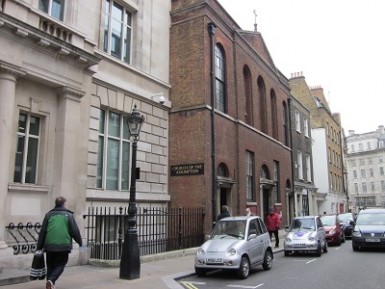
(former Bavarian Embassy chapel, Now the church of Our Lady of the Assumption & St. Gregory)
Such chapels were centres of musical excellence and musical example, in 1792 the Spanish Chapel stated that ‘instruction is given gratis to those who offer to learn church music’. Moreover they constituted a crucial link with Catholic music on the continent, especially since their choirs included professional singers from the London opera scene. For example, Giovanni Liverati (1772-1846), composer and conductor at the King’s Theatre, worked at the Bavarian embassy chapel, which came to be known as the ‘Shilling opera’. Other professionals were its choirmaster Gesualdo Lanza (1779-1839), Begrez (1787-1803) and Manuel Garcia (1776 [sic]-1832), who composed three masses for the chapel. As a result, an operatic performance style became an established feature in many Catholic choirs before Vatican II. [T.E. Muir, Roman Catholic church music in England, 1791-1914: a handmaid of the liturgy? (2008), pp. 75-76]
Indeed, the operatic bel
canto style, complete with elaborate cadenzas for solo
singers, is not lacking in García's masses.
There are four masses by García contained either in autograph in
the Bibliothèque Nationale in Paris or in copies in the Boston
Public Library made in 1859-60 by Charles M. Baetens (not to be
confused with Charles Baetens, the
celebrated violist!). The autograph of the Messa 1a
gives the date 1818, which supports Sterling MacKinlay's
assertion above. And it is probably the third mass (with its
charming tenor/bass duet on "Laudamus te") that elicited the
praise of noted lawyer Charles
Butler (1750-1832) in 1819:
No one can be more sensible than I am, of the exquisite beauty of the masses now sung in the chapels of the Bavarian and Portuguese ambassadors. Since the days of Pergolesi, a more exquisite composition for the church, than Garcia's mass, has not been heard; and those, who have not assisted at it, have not heard the most perfect execution of vocal music, at once elegant, pathetic and sublime, that has yet been exhibited in this country.—The words bonae voluntatis, laudamus te, and the Crucifixus etiam pro nobis, are masterpieces of learning and pathos, at once simple, elegant, sublime, and,—without which all church music fails,—highly devotional. They will not suffer in a comparison with the finest passages in the masses of Haydn or Mozart. [pp. 277-8]
********
Some of the finest services of Haydn and Mozart, and recently the service composed by Signor Garcia, which we have already mentioned, are now excellently performed at the Bavarian chapel. Even in this era of musical excellence, it may be doubted whether those, who have not heard that service performed as it now is, by Begrez, by Garcia, and by the Naldis,—have heard the most perfect singing, which England possesses. [p. 281]
[Butler, The life of Fénelon, Archbishop of Cambray, 3rd edition. To which are added, The lives of St. Vincent of Paul and Henri-Marie de Boudon; A letter on ancient and modern music; and Historical minutes of the Society of Jesus. (London: John Murray, 1819). Many thanks to Molly Nelson-Haber for bringing this source to my attention!]
His other compositions consist of “Endimione,” (a cantata for three voices) and several masses, one of which was greatly admired in 1822, when performed at the Bavarian chapel in London.” [John S. Sainsbury et al, A Biographical and Historical Dictionary of Musicians, Vol I, (London: Sainsbury and Co., 1827), p. 267]
How
Charles M. Baetens came into contact with the four García
masses is an interesting question. In 1853 he was the organist
of the French Chapel (located at Little George Street, Portman
Square) when he published his own Mass
of the Annunciation and Mass
of the Assumption. If he made his copies of García's masses from
the autograph in 1859-60, then he must have had contact with
Pauline
Viardot-Garcia in Paris because she was in possession
of all of her father's manuscripts until they were donated
to the Bibliothèque Nationale.
Click to download the score:
Messa 1a
Kyrie
Gloria
Credo
Sanctus/Benedictus
Agnus
Dei
Messa 2a
Messa 3a
Kyrie
Gloria
Credo
Sanctus/Benedictus
Agnus
Dei
García's third Mass was
given its modern world-premiere performance on April 26, 2015 by
the Citrus Hill High School Chamber Singers, conducted by
Jonathan Frias, with soloists Vaigafa Tanielu, soprano, Danielle
Perrault, alto, Julio Carrillo Batta, tenor, Bradley Franklin,
bass, and accompanied by Pam Schomaker, organ. Click to see and
hear a video recording of that performance: Messa 3a.
Messa
4a
Kyrie
Gloria
Credo
Click to hear a performance of the Credo
from Messa 4a performed by the combined Chamber Singers and
Concert Choir at California
State University San Bernardino, conducted by John Russell, on
March 11, 2014.
Sanctus
Benedictus
Agnus
Dei
This
music is for personal use only. All copyright restrictions
apply.
Click to listen to synthesized performances (may Manuel García
forgive me!);
although the "performance" is robotic, it can still provide a
rough idea of the music:
Messa 1a
Kyrie
audio
Gloria
audio
Credo
audio
Sanctus/Benedictus
audio
Agnus
Dei audio
Messa 2a
Kyrie
audio
Gloria
audio
Credo
audio
Sanctus/Benedictus
audio
Agnus
Dei audio
Messa 3a
Kyrie audioMessa 4a
Kyrie
audio
Gloria
audio
Credo
audio
Sanctus
audio
Benedictus
audio
Agnus
Dei audio